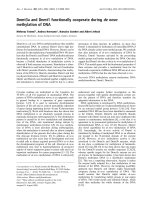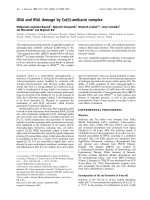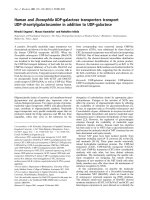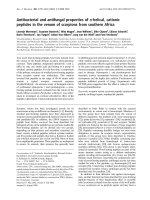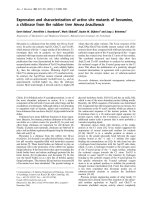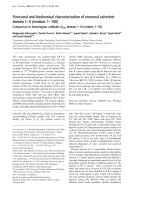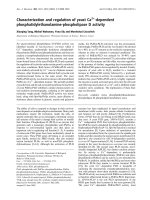Báo cáo y học: " Challenges and patenting strategies for Chinese herbal medicine" pdf
Bạn đang xem bản rút gọn của tài liệu. Xem và tải ngay bản đầy đủ của tài liệu tại đây (297.11 KB, 4 trang )
Wang and Chan Chinese Medicine 2010, 5:24
/>Open Access
COMMENTARY
© 2010 Wang and Chan; licensee BioMed Central Ltd. This is an Open Access article distributed under the terms of the Creative Com-
mons Attribution License ( which permits unrestricted use, distribution, and reproduc-
tion in any medium, provided the original work is properly cited.
Commentary
Challenges and patenting strategies for Chinese
herbal medicine
Xinsheng Wang
1
and Albert Wai-Kit Chan*
2
Abstract
Patents for Chinese herbal medicines can be difficult to obtain. When the active ingredients of an herbal formula are
known, danfang (single herb prescriptions) is better protected with quantified composition claims. When the active
ingredients are unknown, 'product by processing', 'method of processing', 'method of administration' and 'new use
claims' are often powerful tools to distinguish a traditional danfang from 'the prior art'. Additional patents may also be
filed continuously in the product development process. Existing patents for fufang (composite prescriptions) are
primarily drafted to protect traditional herbal formulations. More efforts are needed to protect various herbal
combinations and their multiple applications.
Introduction
Keeping Chinese medicine formulae as trade secrets has
led to some losses of knowledge and experience accumu-
lated over generations. Drugs as well as dietary supple-
ments are subject to regulations and disclosure
requirements; it has become increasingly difficult for CM
practitioners to keep their prescriptions and treatment
methods as trade secrets. In 1993, the Chinese govern-
ment issued the Regulations on the Protection of Tradi-
tional Chinese Medicines which, to this date, provides
administrative protection to certain prescriptions and
manufacturing processes [1].
For developing new drugs and improved formulations,
many Chinese herbs are being studied by major pharma-
ceutical companies with modern technologies. These
companies rely on patent to protect their intellectual
properties. Due to vast philosophical differences between
CM and Western medicine, there are challenges in patent
applications for CM-related products. The present article
discusses some of the challenges and proposes solutions
to these challenges.
Discussion
Types of Chinese medicine prescriptions
According to Chinese medicine theory, local pathologic
changes are always considered to be connected with the
entire body [2]. A strategic combination of different
ingredients of herbs is necessary to generate specific and
synergistic effects.
In Chinese medicine prescriptions, single herb pre-
scriptions are called danfang [3] whereas multiple herb
prescriptions are called fufang [3] which are thought to
synergize the therapeutic effects of different ingredients
while minimize their toxicities [4]. Fufang is much more
commonly used than danfang [4].
Patenting strategies for danfang prescriptions
Patenting a danfang with known active ingredients
Active ingredients in a danfang may be chemically syn-
thesized and their chemical structures may be further
modified for improved safety and efficacy. Quinine, the
first effective antimalarial drug, was originally discovered
from the bark of the cinchona tree.
The traditional herbal form of the medicine may still
exist even after the active ingredients have been devel-
oped into a pure-compound drug. For example, berberine
is an isoquinoline alkaloid isolated from plants such as
Rhizoma Coptidis (Huanglian) and Cortex Phellodendri
(Huangbai). While berberine hydrochloride, documented
for its strong antibiotic and anti-inflammatory effects,
has been marketed as a pure-compound drug, herbal for-
mulae comprising Rhizoma Coptidis are still widely pre-
scribed, e.g. Coptis extract tablets (Huangliansu Pian)
and Coptis teapills (Huangliansu Wan) with indications
such as diarrhea, dysentery, indigestion and infections.
As such, patents for the traditional herbal form of these
products and patents for the pure chemical drugs may co-
* Correspondence:
2
Law Offices of Albert Wai-Kit Chan, PLLC, Whitestone, NY 11357, USA
Full list of author information is available at the end of the article
Wang and Chan Chinese Medicine 2010, 5:24
/>Page 2 of 4
exist. Information of known active ingredients of an
herbal medicine should be incorporated into its patent.
Information such as whether the chemical structures are
racemates or chiral enantiomers, or how the precise
quantity range of the active ingredients in the herbal
product can be determined by analytical techniques such
as gas chromatography (GC), high performance liquid
chromatography (HPLC) and mass spectroscopy (MS).
Patenting strategies for danfang with unknown active
ingredients
While a danfang with unknown active ingredients can be
patented, novelty plays a key role in its patent application.
In terms of composition claims, danfang formulae are
more vulnerable to 35 U.S.C. 102 or 35 U.S.C. 103 rejec-
tions than fufang. Most herbs with medical effects have
been somewhat disclosed 'in prior art'. Such claims as 'a
composition for treating X disease comprising H (a single
herbal ingredient)' are almost invariably rejected for lack
of novelty or inventive step although a traditional dan-
fang formula may still be protected by a number of
approaches including 'method of processing', 'product by
processing', 'method of administration' and 'new use of
the herb'. 'Product by processing' remains a powerful tool
to distinguish a traditional danfang from 'prior art'. For
example, U.S. Pat. 7,101,535 claims 'an oral composition
effective against halitosis comprising an extract from
Moutan bark (Paeonia suffruticosa Andrews) as an active
ingredient'. While the claim was rejected for lack of nov-
elty over prior patents, the 'product by processing' claim
was allowed.
To obtain a patent for a commonly used herb as long as
there is a novel perspective in the formula. For example,
U.S. Pat. 7,575,772 is based on the 'process and composi-
tion for syrup and jam from Luohanguo (Siraitia grosve-
nori or Momordica grosvenori) which is the fruit of the
plants belonging to Curcubitaceae family'. Luohanguo as
a remedy for respiratory complaints (e.g. dry coughs) has
been used in many Chinese medicine formulae. While
the Encyclopedia of Traditional Chinese Medicine [5] rec-
ommends the use of Luohanguo as a laxative, the appli-
cants of this patent claimed that the whole Luohanguo
fruit may be processed as a natural sweetener. As 'prior
art' recommended to remove the seeds and husks of Luo-
hanguo, the applicants protected a unique aspect of the
formula by claiming to process the whole fruit extract.
Patent protection of the development process
Companies developing a danfang herbal product may file
patents on an on-going basis to protect various stages of
the development. When the mechanism of an herbal for-
mula has been elucidated, or when new applications have
been discovered from a danfang, a series of patents must
be filed along with the development process.
Found in northern China, Xanthoceras sorbifolia Bunge
(Wenguanguo) is a species of the sapindaceae family. Its
seeds have been used as a folk medicine to treat enuresis
[6]. U.S. Pat. No. 6,616,943 was drawn to an herbal for-
mula comprising Wenguanguo to prevent cerebral aging,
improve memory and cerebral functions and cure enure-
sis and to treat frequent micturition, urinary inconti-
nence, dementia, weak intelligence and Alzheimer's
disease, autism, brain trauma, Parkinson's disease and
other diseases related to cerebral dysfunction. U.S. Pat.
7,189,420 claims an extract of Wenguanguo husk for use
as a medicine or food supplement. U.S. Pat. 7,514,412
claims novel compounds isolated from Wenguanguo that
have anticancer activities. Those novel compounds may
be either extracted from natural sources or synthesized
chemically. Currently, U.S. Pat. 7,262,285 covers the
derivatives of the isolated active ingredients.
Patenting strategies for fufang prescriptions
Patent protection of herbal formulations
A strategy for protecting herbal formulations is to divide
the compositions into several groups and (1) specify the
composition with the most essential herbs in the inde-
pendent claim; (2) specify the compositions with addi-
tional herbs as dependent claims. For example:
Claim 1: A composition for treating disease X com-
prising H1, H2 and H3.
Claim 2: A composition of claim 1, wherein the com-
position further comprises H4.
Claim 3: A composition of claim 1, wherein the com-
position further comprises H5.
Claim 4: A composition of claim 1, wherein H3 is
replaced by H3A, H3B or H3C.
Many patentees have tried to use Markush claims to
protect alternative compositions. Markush claims, how-
ever, are prone to the restriction requirement under 35
U.S.C. 121. For example, the original claim 6 of U.S. Pat.
7,465,466 entitled Compositions and Methods for Prostate
and Kidney Health and Disorders, an Herbal Preparation
was drafted to recite
'A M e tho d co mp ris in g:
identifying a subject with a kidney disorder and
establishing a regimen for administering a composi-
tion comprising an aliquot of
the Herba Epimedii and
an aliquot of at least three supplemental herbs
selected from the group of Fructus Rosae Laerigatae,
Fructus Rubi, Fructus Psoralea, Radix Morindae offci-
nalis, Fructus Schisandrac Chinensis, Fructus Ligustri
Lucidi, Semen Cuscutae and Radix Astragali' [7].
This claim was rejected and the examiner requested the
applicant to select a species of the herbs. The final claim
was subsequently amended to be 'A method comprising
identifying a human subject with a kidney disorder
and
Wang and Chan Chinese Medicine 2010, 5:24
/>Page 3 of 4
establishing a regimen for administering a composi-
tion to the subject, the
composition formulated to restore stasis in the kidney
comprising
an aliquot of the Herba Epimedii and
an aliquot of each of supplemental herbs selected
from the group consisting of Fructus Rosae Laeriga-
tae, Fructus Rubi, Fructus Psoralea, Radix Morindae
offcinalis, Fructus Schisandrac Chinensis, Fructus
Ligustri Lucidi, Semen Cuscutae and Radix Astragali'
[7].
While the patent was eventually issued, the scope of the
patent was much narrower than intended.
The restriction requirement may be bypassed if a func-
tional term is used to 'label' the interchangeable herbs in a
group. The United States Patent and Trademark Office
(USPTO) would not refuse to examine a claim that con-
tains alternative language unless the subject matter of the
claim lacked a 'unity of invention' [8]. The USPTO cur-
rently considers the 'unity of invention' to exist in a
Markush group where the members of the group (1)
share a common utility and (2) share a substantial feature
essential to that utility [9]. Therefore, a functional lan-
guage or generic terminology may be used to describe a
group as sharing a 'common utility' to meet the 'unity of
invention' requirement. For example,
Claim 1 U.S. Pat. 6,280,751 for 'essential oil' recites that
'a medicinal or cosmetic composition for oral administra-
tion comprising at least one essential oil in combination
with at least one spice selected from the group consisting
of Acacia Catechu, Acanthopanax, Gracilistylus, Caesal-
pinia Sappan, Epimedium Spinosa, Paeonia lactiflora,
Paeonia obovata, Atractylodes macrocephala, Glycyr-
rhiza uralexisis, Glycyrrhiza glabra, Lycium chinense,
Nauclea rhyncholphylla, Cinnainomum cassia, Astrag-
alus membranaceus, Scutellaria, baicalensis,
Schizonepeta tenuifolia, Ephedra sinica, Ophiopogon
japonicus, Paeonia suffruticosa, Artemisia annua, Are-
temisia apiacea, Panax notoginseng, Cornus officinalis,
Acorrius gramineus, Reluhania glutinosa, Gastroidia
elata, Asparagus cochiichinensis, Cuscuta chinensis, Schi-
zandra chinensis, Schizandra spenanthera, Magnolia lili-
flora, Epimediumbrevicomum, Epimedium grandiflorun,
Epimedium brevicomum, Epimedium grandiflorun, Epi-
medium sagittatum, Houttuynia cordata, Polygala tenui-
folia and Perilla frutescents and Aloe vera extract.
Claim 2 recites that 'a medical or cosmetic composition
according to claim 1, wherein the essential oil is selected
from the group consisting of bergamot, chamomile ger-
man, chamomile maroc, chamomile roman, cinnamon
zeylanicum, clove buds, eucalyptus globules, frankincense,
fennel, hyssop, juniper, lemon grass, mountain savory,
niaouli, red thyme, rosemary, rose geranium, tagestes and
ylang ylang.'
Both claims 1 and 2 are allowable despite the long list of
herbs enumerated in the Markush claim possibly because
the alternative herbs belong to two functional groups,
namely 'spice' and 'essential oil.'
Protection of multiple fufang applications
In Chinese medicine, a fufang formula may be used to
treat a range of diseases, the philosophy of which is in
stark contrast with Western medicine. Claims that a
fufang prescription is effective to treat multiple diseases
often impede a patent application. These claims are often
rejected on the grounds of 35 U.S.C. 112 as 'lack of
enablement.'
Under these circumstances, a patent application may be
divided into various medical targets for each herbal com-
position. In a hypothetical example, a fufang formula is
effective to quickly heal skin damage caused by trauma,
burning or fungal infection. The herbal composition
exhibits strong antibacterial and antifungal effects both
in vivo and in vitro. In this case, several separate patents
should be filed for each therapeutic category. One patent
should emphasize the antibacterial effects. Another pat-
ent should emphasize the applications of the herbal com-
position for treating skin infections caused by fungi
pathogens (e.g. athletes' foot).
In an actual case, an herbal medicine company discov-
ered that a fufang formula reduced inflammation. In par-
ticular, the herbal formula inhibits Cyclooxygenase
(COX) which is an enzyme-protein complex associated
with inflammation. A number of diseases and/or symp-
toms are associated with the inflammation reactions con-
trolled by COX isoenzymes, such as prostate cancer,
prostatic intraepithelial neoplasia and glioblastoma
(brain tumor). The inventors of the formula obtained a
series of patents, of which U.S. Pat. 6,387,416 claims a
method of using the composition to reduce inflamma-
tion; U.S. Pat. 7,067,159 claims a method of treating pros-
tate cancer; U.S. Pat. 7,070,816 claims a method of
treating prostatic intraepithelial neoplasia and precancer-
ous cellular proliferations within prostatic ducts, ductiles
and acini; U.S. Pat. 7,622,142 claims a method of using
the same (or similar) composition to treat brain tumor.
A powerful patent protection for a fufang formula may
be obtained as long as the chemical structures of its
major active ingredients are identified, however, this is
extremely difficult to achieve as fufang is processed from
a mixture of herbs with hundreds of thousands of com-
pounds. To this date, most successfully obtained patents
for fufang formulae are those protecting their herbal
compositions and formulations.
Conclusion
A powerful patent protection for an herbal formula may
be obtained when the chemical structures of each active
ingredient are identified and patented. While this is a rel-
Wang and Chan Chinese Medicine 2010, 5:24
/>Page 4 of 4
atively easy task for danfang formulae, it remains a very
daunting task for fufang formulae. As a result, the current
patents for fufang formulae protect only the traditional
herbal formulations. More efforts from the research com-
munity are needed to protect the various herbal combi-
nations as well as the multiple applications of fufang
formulae.
Abbreviations
CM: Chinese medicine; GC: gas chromatography; HPLC: performance liquid
chromatography; MS: mass specturoscopy; Pat: Patent; US: United States;
USPTO: United States Patent and Trademark Office; COX: Cyclooxygenase
Competing interests
The authors declare that they have no competing interests.
Authors' contributions
AC supervised the study and revised the manuscript. XW conducted the
research and drafted the manuscript. Both authors read and approved the final
version of the manuscript.
Acknowledgements
We wish to thank Jiaher Tian for his research ideas and Guanghua Chen for pro-
viding information on Chinese medicine principles. We also thank Julie Lai for
editing the manuscript.
Author Details
1
DeHeng Chen, LLC, 225 Broadway, Suite 1910, New York, NY 10007, USA and
2
Law Offices of Albert Wai-Kit Chan, PLLC, Whitestone, NY 11357, USA
References
1. The State Council of the People's Republic of China: Regulations on
Protection of Traditional Chinese Medicines PRC: State Council; 1992.
Decree No. 106
2. Koopsen C, Young C: Integrative Health - A Holistic Approach for Health
Professionals Sudbury: Jones and Bartlett Publishers, LLC; 2009.
3. Hsiao JIH: Patent protection for Chinese herbal medicine product
invention in Taiwan. J World Intellect Prop 2007, 10(1):1-21.
4. Chan K: Understanding the toxicity of Chinese medicinal products. In
The Way Forward for Chinese Medicine Edited by: Chan K, Lee H. London:
Taylor & Francis; 2002:71-91.
5. Jiangsu College of New Medical: The Encyclopedia of Traditional Chinese
Medicine Zhejiang: Jiangsu College; 1977.
6. Fu H, Guo Y, Li W, Dou D, Kang T, Koike K: A new angeloylated
triterpenoid saponin from the husks of Xanthoceras sorbifolia Bunge. J
Nat Med 2010, 64:80-84.
7. Chou WH: Compositions and methods for prostate and kidney health
and disorders, an herbal preparation. US Patent 7,465,466 2008.
8. The Unites States Patent and Trademark Office: Manual of Patent
Examining Procedures Alexandria, USA: Patent and Trademark Office; 2010.
9. In re Harnisch, 631 F.2d 716, 206 U.S.P.Q. 200 (C.C.P.A. 1980). .
doi: 10.1186/1749-8546-5-24
Cite this article as: Wang and Chan, Challenges and patenting strategies for
Chinese herbal medicine Chinese Medicine 2010, 5:24
Received: 23 February 2010 Accepted: 16 July 2010
Published: 16 July 2010
This article is available from: 2010 Wang and Chan; licensee BioMed Central Ltd. This is an Open Access article distributed under the terms of the Creative Commons Attribution License ( ), which permits unrestricted use, distribution, and reproduction in any medium, provided the original work is properly cited.Chinese Med icine 2010, 5:24

